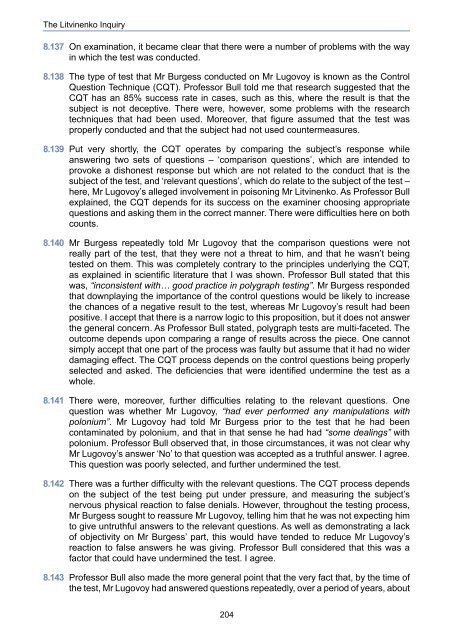The Litvinenko Inquiry
JIEp7Zyr
JIEp7Zyr
You also want an ePaper? Increase the reach of your titles
YUMPU automatically turns print PDFs into web optimized ePapers that Google loves.
<strong>The</strong> <strong>Litvinenko</strong> <strong>Inquiry</strong><br />
8.137 On examination, it became clear that there were a number of problems with the way<br />
in which the test was conducted.<br />
8.138 <strong>The</strong> type of test that Mr Burgess conducted on Mr Lugovoy is known as the Control<br />
Question Technique (CQT). Professor Bull told me that research suggested that the<br />
CQT has an 85% success rate in cases, such as this, where the result is that the<br />
subject is not deceptive. <strong>The</strong>re were, however, some problems with the research<br />
techniques that had been used. Moreover, that figure assumed that the test was<br />
properly conducted and that the subject had not used countermeasures.<br />
8.139 Put very shortly, the CQT operates by comparing the subject’s response while<br />
answering two sets of questions – ‘comparison questions’, which are intended to<br />
provoke a dishonest response but which are not related to the conduct that is the<br />
subject of the test, and ‘relevant questions’, which do relate to the subject of the test –<br />
here, Mr Lugovoy’s alleged involvement in poisoning Mr <strong>Litvinenko</strong>. As Professor Bull<br />
explained, the CQT depends for its success on the examiner choosing appropriate<br />
questions and asking them in the correct manner. <strong>The</strong>re were difficulties here on both<br />
counts.<br />
8.140 Mr Burgess repeatedly told Mr Lugovoy that the comparison questions were not<br />
really part of the test, that they were not a threat to him, and that he wasn’t being<br />
tested on them. This was completely contrary to the principles underlying the CQT,<br />
as explained in scientific literature that I was shown. Professor Bull stated that this<br />
was, “inconsistent with… good practice in polygraph testing”. Mr Burgess responded<br />
that downplaying the importance of the control questions would be likely to increase<br />
the chances of a negative result to the test, whereas Mr Lugovoy’s result had been<br />
positive. I accept that there is a narrow logic to this proposition, but it does not answer<br />
the general concern. As Professor Bull stated, polygraph tests are multi-faceted. <strong>The</strong><br />
outcome depends upon comparing a range of results across the piece. One cannot<br />
simply accept that one part of the process was faulty but assume that it had no wider<br />
damaging effect. <strong>The</strong> CQT process depends on the control questions being properly<br />
selected and asked. <strong>The</strong> deficiencies that were identified undermine the test as a<br />
whole.<br />
8.141 <strong>The</strong>re were, moreover, further difficulties relating to the relevant questions. One<br />
question was whether Mr Lugovoy, “had ever performed any manipulations with<br />
polonium”. Mr Lugovoy had told Mr Burgess prior to the test that he had been<br />
contaminated by polonium, and that in that sense he had had “some dealings” with<br />
polonium. Professor Bull observed that, in those circumstances, it was not clear why<br />
Mr Lugovoy’s answer ‘No’ to that question was accepted as a truthful answer. I agree.<br />
This question was poorly selected, and further undermined the test.<br />
8.142 <strong>The</strong>re was a further difficulty with the relevant questions. <strong>The</strong> CQT process depends<br />
on the subject of the test being put under pressure, and measuring the subject’s<br />
nervous physical reaction to false denials. However, throughout the testing process,<br />
Mr Burgess sought to reassure Mr Lugovoy, telling him that he was not expecting him<br />
to give untruthful answers to the relevant questions. As well as demonstrating a lack<br />
of objectivity on Mr Burgess’ part, this would have tended to reduce Mr Lugovoy’s<br />
reaction to false answers he was giving. Professor Bull considered that this was a<br />
factor that could have undermined the test. I agree.<br />
8.143 Professor Bull also made the more general point that the very fact that, by the time of<br />
the test, Mr Lugovoy had answered questions repeatedly, over a period of years, about<br />
204


